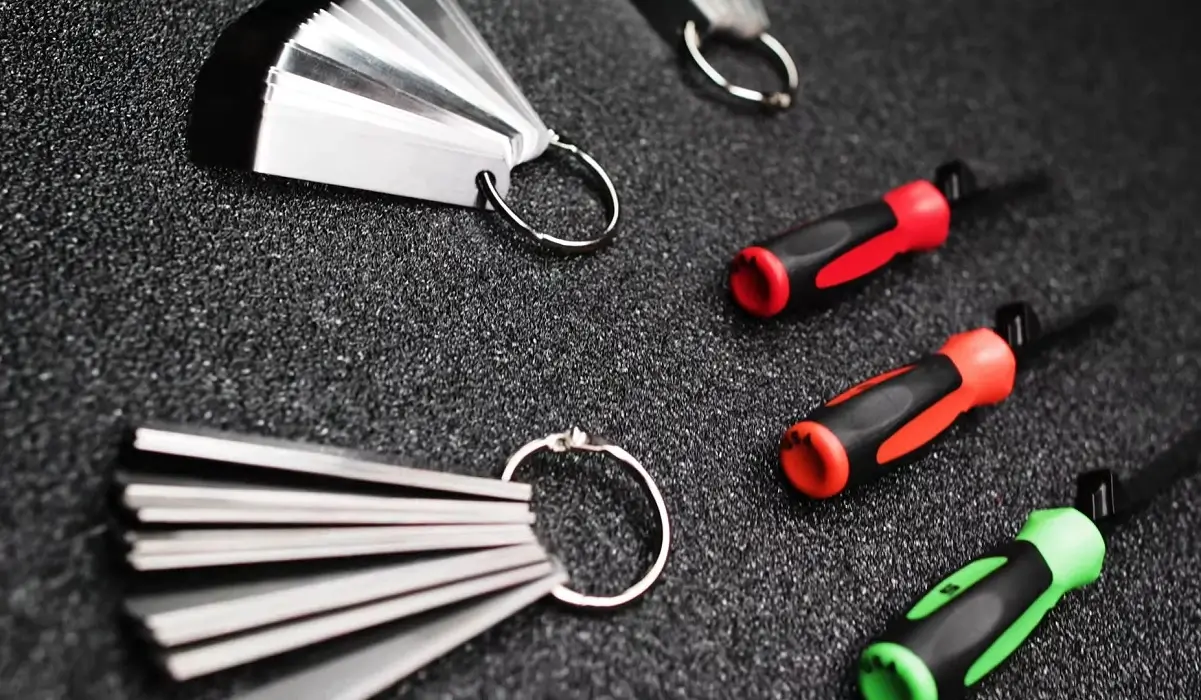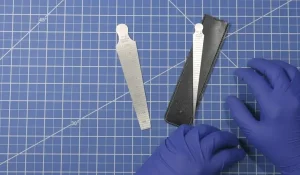
What Does a Feeler Gauge Set Metric?
A feeler gauge set in metric measurements typically includes blades with thicknesses specified in millimeters. These sets are designed for applications that use the metric system of measurement. The blades in a metric feeler gauge set may range in thickness from very thin (e.g., 0.03 mm) to thicker sizes (e.g., 1.0 mm or more), depending on the specific set.
When selecting a feeler gauge set, look for one that provides a comprehensive range of metric blade sizes to cover a variety of measurement needs. The set may come in a holder or handle that allows for easy selection and storage of the blades. Some sets may also include dual-marked blades that provide measurements in both metric and imperial (inch) units for added versatility.
Using a metric feeler gauge set follows the same principles as using any other feeler gauge set. Ensure the blades are securely held in place, position the gauge perpendicular to the surfaces being measured, insert the blade into the gap, and assess the fit for the appropriate measurement.
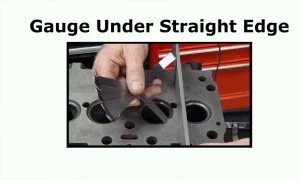
Whether you’re working on metric-specific projects or in an industry that predominantly uses the metric system, a feeler gauge set with metric measurements will help you achieve precise gap and clearance measurements.
A feeler gauge set with handles typically includes a set of individual feeler gauge blades that can be inserted into a handle or holder for ease of use and organization. The handles or holders provide a comfortable grip and make it convenient to interchange the blades as needed. Here are a few key points about feeler gauge sets with handles:
Interchangeable Blades: These sets consist of a handle or holder that accommodates multiple blades of varying thicknesses. The blades can be easily inserted or removed from the handle, allowing for quick blade changes and customization.
Easy Handling: The handles or holders are designed to provide a secure and comfortable grip, making it easier to manipulate the feeler gauge during measurements. This ergonomic design enhances usability and reduces hand fatigue.
Organization: Feeler gauge sets with handles often come with storage cases or sleeves that keep the blades organized and protected when not in use. This makes it convenient to locate and access the desired blade when needed.
Versatility: With interchangeable blades, these sets offer versatility in terms of the range of measurements that can be achieved. Users can select the appropriate blade thickness for each specific gap or clearance they need to measure.
Feeler gauge sets with handles provide flexibility, convenience, and improved handling compared to traditional blade-style feeler gauges. They are particularly beneficial in situations where frequent blade changes or different blade sizes are required.
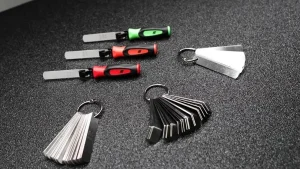
Importance of precision measurements in mechanics
When it comes to mechanical work, precision measurements are crucial for ensuring accurate and reliable results. One tool that plays a key role in achieving this precision is the feeler gauge set. When you’re using a feeler gauge set, mechanics can accurately measure small gaps and clearances between components, helping to ensure proper fit and functionality. This level of precision is essential in tasks such as adjusting valve clearance or measuring gear backlash, where even the smallest deviation can lead to issues down the line.
When you will choose the right type of feeler gauge set depends on factors such as the nature of the work being performed, the level of accuracy needed, and personal preferences regarding ease of use and functionality. You have to understand these distinctions between different types of feeler gauges, SO you can make informed decisions when selecting the most suitable tool for your specific needs.
It’s precision measurement in automotive repairs or fine-tuning machinery in industrial settings, having a diverse collection of feeler gauges ensures that professionals can tackle any task with efficiency and accuracy.
Top Features to Look for in a Feeler Gauge Set
| Feature | Description | Why It’s Important |
|---|---|---|
| Variety of Sizes | A set with many gauges of different thicknesses. | Helps measure various gaps precisely. |
| Material Quality | Gauges made from durable materials like stainless steel. | Ensures long-lasting use and accuracy. |
| Handle Design | Some sets come with a handle for easy use. | Makes the tool easier to manage and control.
|
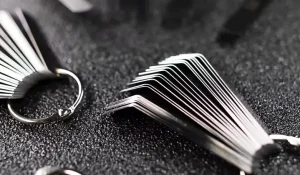
Straight Feeler Gauge: This is the most basic and commonly used type of feeler gauge. It consists of a set of straight blades of varying thicknesses. The blades are usually made of steel and are held together with a pin or screw on one end.
Tapered Feeler Gauge: Tapered feeler gauges have blades that taper to a point at one end. These gauges are useful for measuring gaps in narrow or hard-to-reach spaces, such as spark plug gaps or valve clearances.
Dual-Marked Feeler Gauge: Dual-marked feeler gauges have two different measurement scales on each blade. This type of gauge is helpful when working with both metric and imperial (inch) measurements.
Blade-style Feeler Gauge: Blade-style feeler gauges consist of a set of individual blades that can be inserted into a handle or holder. This allows for easy interchangeability and customization of the gauge set.
Wire Feeler Gauge: Wire feeler gauges use a series of round wire blades of varying diameters to measure gaps. The wire blades are typically bundled together in a holder or handle.
Go/No-Go Feeler Gauge: Go/No-Go feeler gauges are specifically designed to check the tolerance or acceptance of a gap. They consist of two blades: a “go” blade, which should fit into the gap, and a “no-go” blade, which should not fit into the gap. These gauges are commonly used in quality control and inspection processes.
Offset Feeler Gauge: Offset feeler gauges have blades that are bent or angled near the tip. This design allows for easier access to gaps located in tight or obstructed areas.
The specific type of feeler gauge used will depend on the application and the precise measurements required.
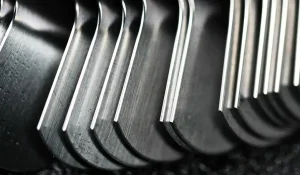
Industries That Rely on Feeler Gauges Set
- Automotive: Mechanics use these gauges to adjust engine parts.
- Manufacturing: Factories need these to check machine parts.
- Construction: Builders use gauges to check materials.
How to Use a Feeler Gauge Set
- Pick the right gauge: Choose a blade that fits your gap.
- Check the gap: Slide the gauge into the space.
- Read and record: When the blade fits snugly, note the measurement.
Here’s a General Guide on How to Use a Feeler Gauge Set:
Select the appropriate feeler blade: Determine the gap or clearance you need to measure and choose the feeler blade that is closest in thickness to the expected size of the gap.
Prepare the feeler gauge: If you’re using a blade-style feeler gauge, insert the selected feeler blade into the handle or holder if necessary. Ensure that the blade is securely held in place.
Position the feeler gauge: Place the feeler gauge perpendicular to the surfaces being measured. Ensure that the blade is parallel to the surfaces and properly aligned.
Insert the feeler gauge blade: Gently slide the feeler gauge blade into the gap or space you want to measure. Apply light pressure to ensure proper contact between the blade and the surfaces.
Check the fit: Once the blade is inserted, assess the fit. It should be snug but still allow a slight drag when removing the blade. If the blade is too loose or too tight, try a different blade thickness until you find the one that provides the best fit.
Read the measurement: Look at the marking or label on the selected feeler blade to determine its thickness. This measurement represents the size of the gap or clearance you just measured.
Repeat if necessary: If you need to measure multiple gaps or different areas, repeat the process with the appropriate feeler blades for each gap.
Record the measurements: Note down the measurements for future reference or use in your project or task.
Remember, when using a feeler gauge, it’s important to handle it with care and avoid applying excessive force or bending the blades. Proper usage and accurate measurements will help ensure the desired fit and functionality of the components you’re working with.
Maintenance Tips for Your Feeler Gauge Set
To keep your feeler gauges accurate and in good shape, follow these guidelines:
- Keep them clean: Wipe each blade after use.
- Protect against rust: Store them in a dry place.
- Handle with care: Be gentle to avoid bending them.
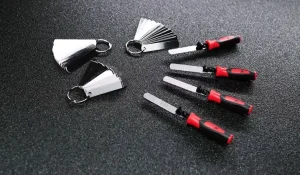
F A Q about Feeler Gauge Set
What are Feeler Gauges Used to Set?
Feeler gauges are primarily used to set and adjust precise clearances and gaps in various mechanical applications. Some common uses include setting valve clearances in engines, adjusting spark plug gaps for proper ignition, ensuring accurate bearing clearances, aligning and adjusting components in machinery, setting gaps in electrical contacts, and fine-tuning the spacing between mating parts.
Feeler gauges are essential tools for achieving optimal performance, preventing damage or wear, and ensuring proper functioning of mechanical systems. Their ability to provide precise measurements and facilitate accurate adjustments makes them invaluable in industries such as automotive, manufacturing, engineering, and maintenance.
Which Feeler Gauge is Best?
The best feeler gauge depends on the specific application and measurement requirements. Different projects may call for different types or sizes of feeler gauges. It is important to choose a feeler gauge set that offers a range of blade thicknesses, is made of high-quality materials for durability, and provides accurate and consistent measurements. Consider factors such as the intended use, the required measurement range, and the quality of the gauge set when determining the best feeler gauge for your needs.
What Are The Disadvantages of Feeler Gauge?
Some potential disadvantages of feeler gauges include limited flexibility in measuring irregular or non-linear gaps, difficulty in accessing tight or hard-to-reach spaces, and the potential for user error if not used carefully or if the blades are not securely held in place.
What is The Correct Use of Feeler Gauge?
To properly use a feeler gauge, select the appropriate blade thickness for the desired measurement. Position the gauge perpendicular to the surfaces being measured, insert the blade into the gap, and assess the fit. The blade should provide a snug fit with a slight drag when removing it, indicating the correct measurement.
What is 010 on a Feeler Gauge?
“010” on a feeler gauge refers to a blade thickness. Feeler gauges typically have blades with different thicknesses marked on them. In this case, “010” indicates a blade thickness of 0.010 inches or 0.25 millimeters. It represents the specific size of the gap or clearance that can be measured using that particular blade of the feeler gauge.
Can You Stack Feeler Gauges?
Yes, it is possible to stack feeler gauges together to achieve a combined thickness. This technique can be useful when a specific measurement falls between the available blade sizes. By stacking multiple feeler gauges, you can approximate the desired thickness and achieve the desired gap or clearance measurement.
Conclusion
A feeler gauge set is something that helps you work better. It tells you the space between parts, so everything fits right. Taking care of this tool means it will help you for a long time.
Feeler gauges are indispensable tools for achieving precision in various mechanical and engineering applications. Their ability to accurately measure gaps and clearances ensures proper fit and functionality of components. By using feeler gauges, you can fine-tune adjustments, such as valve clearances or spark plug gaps, with utmost precision.
Feeler gauges offer a wide range of blade thicknesses, allowing you to select the exact size needed for your specific measurement requirements. This level of precision helps prevent inaccuracies and potential performance issues. Whether you’re working on automotive engines, machinery, or other mechanical systems, feeler gauges enable you to achieve optimal tolerances and ensure efficient operation.
Simply selecting the appropriate blade, positioning it correctly, and reading the measurement, feeler gauges provide a user-friendly experience while maintaining accuracy. By incorporating feeler gauges into your toolkit, you can enhance your precision, save time, and ensure the highest quality in your projects or maintenance tasks.

